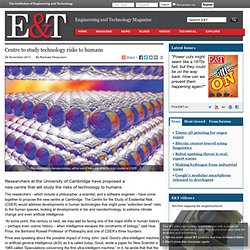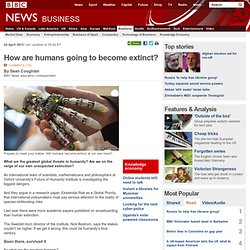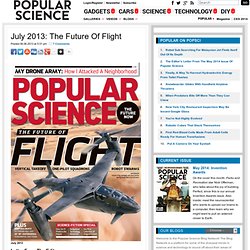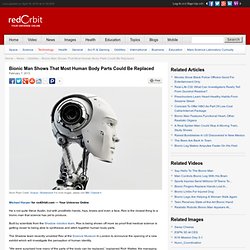

Centre to study technology risks to humans. Researchers at the University of Cambridge have proposed a new centre that will study the risks of technology to humans.

How are humans going to become extinct? 24 April 2013Last updated at 05:42 ET By Sean Coughlan BBC News education correspondent Prepare to meet your maker: Will humans become extinct at our own hand?

What are the greatest global threats to humanity? Are we on the verge of our own unexpected extinction? An international team of scientists, mathematicians and philosophers at Oxford University's Future of Humanity Institute is investigating the biggest dangers. And they argue in a research paper, Existential Risk as a Global Priority, that international policymakers must pay serious attention to the reality of species-obliterating risks.
Smart phone modifications. Data. 3D printing. July 2013: The Future Of Flight. Dear Mr Editor,

Flexible Glass Solar Cells Could Boost Effectiveness of Solar Shingles. Man Has 75 Percent of His Skull Replaced By a 3D Printed Implant. Feel like you have lost your head?

No problem, simply print yourself another. An unnamed man from the US was able to do just that, courtesy of Oxford Performance Materials (OPM) in Connecticut. He had his cranium scanned by a 3D scanner before the prosthesis was formed to fit his features, and the resulting plate was surgically implanted earlier this week. The technology, called the OsteoFab Patient Specific Cranial Device, received FDA approval on February 18 of this year, and it’s now ready to take the field of medical 3D printing to a level that is literally head and shoulders above the competition. A Tiny, Fold-up Electric Car Will Hit Streets This Year. Hay (well, straw) could fuel future airplanes.
Giant robot jellyfish reporting for recon duty, sir (video) Micro-LED LiFi: Where every light source in the world is also TV, and provides gigabit internet access. Researchers at the University of Strathclyde in Scotland has begun the task of bringing high-speed, ubiquitous, LiFi technology to market.

If Martin Dawson and Harald Haas have their way, any illuminated device — your TV, your bedside lamp, a road sign, a train or airport timetable — might soon double up as a wireless LiFi hotspot. LiFi, as you may have guessed, stands for Light-Fidelity — as in, Wireless-Fidelity (WiFi), but using visible light instead of gigahertz radio waves. How LiFi works is very simple: You have an a light on one end (an LED in this case), and a photodetector (light sensor) on the other. If the LED is on, the photodetector registers a binary one; otherwise it’s a binary zero. Flash the LED enough times and you build up a message. China visa changes could attract job-hunting IT pros. High performance access to file storage A change to China’s visa laws due to come into force this (northern) summer could make the People’s Republic a more attractive destination for ex-pat IT professionals up for the challenge, but the vital details on exactly which skills are needed are still being worked out.

The Exit and Entry Administration Law comes into force in July, introducing for the first time multi-entry visas which are valid for five years, as well as six-month visas for short-term recruits, according to China Daily. The new rules are set to take effect as part of China’s long-term plans to attract the very best talent, or “international experts”, to the country. Stromer Electric Bicycle. Best known for their chocolate, watches and banks, the Swiss are also quite skilled bicycle makers as it turns out.

Synthetic biology: building in barriers. Bionic Man Unveiled At London's Science Museum. February 7, 2013 Michael Harper for redOrbit.com — Your Universe Online He´s not quite Steve Austin, but with prosthetic hands, hips, knees and even a face, Rex is the closest thing to a bionic man that science has yet to produce.

Built by scientists from the Shadow robotics team, Rex is being shown off more as proof that medical science is getting closer to being able to synthesize and stitch together human body parts. The Shadow team recently unveiled Rex at the Science Museum in London to announce the opening of a new exhibit which will investigate the perception of human identity. Scientists break record for thinnest light-absorber. July 18, 2013 Stanford scientists have built the thinnest, most efficient absorber of visible light on record, a nanosize structure that could lead to less-costly, more efficient, solar cells.

By Mark Shwartz These four wafers contain the thinnest light-absorber ever built. The absorber layer consists of billions of gold nanodots. Cheap, polymer-coated cotton automagically captures water from desert air. NeverWet Arrives - Hands-On Product Demonstration. Researchers successfully grow defect-free graphene, commercial uses now in sight.
The imagined industrial applications for graphene are currently constrained by two things — cost and quality.

There is no concrete roadmap to predict how quickly graphene-based devices will become available and how common they will be. Forget your password: The future is 'passthoughts' (Phys.org) —Instead of typing your password, in the future you may only have to think your password, according to School of Information researchers. A new study explores the feasibility of brainwave-based computer authentication as a substitute for passwords. The project was led by School of Information professor John Chuang, along with Hamilton Nguyen, an undergraduate student in electrical engineering and computer science; Charles Wang, a first-year I School MIMS student; and Benjamin Johnson, formerly a postdoctoral scholar at the I School.
Chuang presented the team's findings this week at the 2013 Workshop on Usable Security at the Seventeenth International Conference on Financial Cryptography and Data Security in Okinawa, Japan. Since the 1980s, computer scientists have proposed the use of biometrics for computer authentication. All that has changed, though, with recent developments in biosensor technologies. New consumer-grade EEG devices.